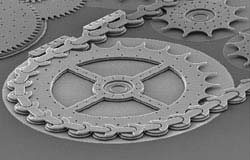Scientists Fabricate Microscale ’Bicycle Chain’

Image: Courtesy of Barry Ritchey/Sandia National Laboratories
Scientists have manufactured a microscale bicycle chain comprised of silicon links thinner than a human hair that behaves just like its regular-sized counterpart. The tiny chain system could one day help power microscopic devices.
Ed Vernon, a technologist at Sandia National Laboratories, designed and patented the 50-link silicon microchain (see image), which was built by the lab’s Microelectronics Development Laboratory (MDL). The centers of the tiny links are separated by just 50 microns. The links can rotate 52 degrees in either direction with respect to their counterparts in the chain without breaking the support structure. Such flexibility, the scientists note, means multiple gears powered by the chain need not lie in a straight line.
Such a gear and chain mechanism could conceivably replace the multiple drivers currently required to run microelectromechanical systems (MEMS) motors. “All those drives take up a lot of real estate on chips,” Vernon notes. A single chain, however, could rotate many drive shafts or drive a MEMS device from a motor situated at a distance. But MEMS researcher Kaigham Gabriel of Carnegie Mellon University observes that “there are very few applications in the commercial space that require continuous rotary motion or the translation thereof.” He also cautions that microscopic gears tend to lock together less tightly than do macroscopic ones. One thing is for certain, any applications that do come of the new work are a long way off. Says Vernon: “I expect it will be three to four years before you’ll see anything this complex out in industry.”
Media Contact
All latest news from the category: Materials Sciences
Materials management deals with the research, development, manufacturing and processing of raw and industrial materials. Key aspects here are biological and medical issues, which play an increasingly important role in this field.
innovations-report offers in-depth articles related to the development and application of materials and the structure and properties of new materials.
Newest articles

High-energy-density aqueous battery based on halogen multi-electron transfer
Traditional non-aqueous lithium-ion batteries have a high energy density, but their safety is compromised due to the flammable organic electrolytes they utilize. Aqueous batteries use water as the solvent for…

First-ever combined heart pump and pig kidney transplant
…gives new hope to patient with terminal illness. Surgeons at NYU Langone Health performed the first-ever combined mechanical heart pump and gene-edited pig kidney transplant surgery in a 54-year-old woman…

Biophysics: Testing how well biomarkers work
LMU researchers have developed a method to determine how reliably target proteins can be labeled using super-resolution fluorescence microscopy. Modern microscopy techniques make it possible to examine the inner workings…





















